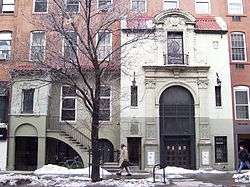Church of Our Lady of Guadalupe (Manhattan)
| Church of Our Lady of Guadalupe | |
|---|---|
| Iglesia Nuestra Señora de Guadalupe | |
 | |
| Location |
229 West 14th Street New York, New York |
| Country | United States |
| Denomination | Roman Catholic Church |
| History | |
| Founded | 1902 |
| Founder(s) | The Rev. Stephen Chaboud, A.A. |
| Dedication | Our Lady of Guadalupe |
| Architecture | |
| Status | closed |
| Architect(s) | Gustave E. Steinback (1921 church facade)<ref name=GSAPP /[1] |
| Architectural type | Townhouse |
| Style |
Spanish Baroque Baroque Revival |
| Years built | ca. 1850, converted to church 1902 |
The Church of Our Lady of Guadalupe (Spanish: Nuestra Señora de Guadalupe), is a former parish church under the authority of the Roman Catholic Archdiocese of New York, located at 229 West 14th Street, between Seventh and Eighth Avenues, in the Greenwich Village section of Manhattan in New York City.
With the merger in 2003 of the Parish of Our Lady of Guadalupe with the Parish of St. Bernard, located farther west on 14th Street, that function was transferred to the nearby St. Bernard Church and the church was converted to other uses.
History
The parish was established in 1902 by the Augustinians of the Assumption as the first Spanish-speaking Catholic parish in New York City, serving working-class Spaniards. At the time, that area of 14th street was considered “Little Spain” and portrayed by filmmaker Artur Balder in his documentaries on Spanish immigration to New York City[2][3] The parish was merged in 2003 with the neighboring St. Bernard Parish to create the Parish of Our Lady of Guadalupe & St. Bernard.
Building
The church building is a former mid-19th-century brownstone rowhouse. Its conversion to a church created a double-story sanctuary. The church also included a "side chapel, tiny balcony, and clerestory." The monumental facade completed in the Spanish Baroque style or "classically proportioned Spanish Revival façade" was built in 1921 to the designs of Gustave Steinback.[2][4] The "transformation which makes Guadalupe extremely rare, if not unique, in the city spanned two decades and involved several notable architects...."[2] The AIA Guide to NYC (Fifth Edition, 2010) called it "an extraordinary brownstone conversion.... Its Iberian ancestry is expressed both in the language of its services and in its Spanish Colonial facade."[5]
The church remained popular with the various Hispanic communities of New York, serving Spaniards, Spanish-Americans, Puerto Ricans, Mexicans and other Latin Americans. The rapid expansion of the Mexican population in the late 20th century, however, overwhelmed the small church, necessitating the congregation's transfer to nearby St. Bernard Church.[4]
References
- ↑ Columbia University Graduate School of Architecture, Planning, and Preservation], "14TH STREET AND UNION SQUARE, PRESERVATION PLAN" (New York City: HISTORIC PRESERVATION PROGRAM GRADUATE SCHOOL OF ARCHITECTURE, PLANNING AND PRESERVATION, COLUMBIA UNIVERSITY, 2006,)(Accessed 13 Jan 2011)
- 1 2 3
- ↑ Remigius Lafort, S.T.D., Censor, The Catholic Church in the United States of America: Undertaken to Celebrate the Golden Jubilee of His Holiness, Pope Pius X. Volume 3: The Province of Baltimore and the Province of New York, Section 1: Comprising the Archdiocese of New York and the Diocese of Brooklyn, Buffalo and Ogdensburg Together with some Supplementary Articles on Religious Communities of Women.. (New York City: The Catholic Editing Company, 1914), p.357.
- 1 2 Our Lady Guadalupe Organs
- ↑ White, Norval; Willensky, Elliot; Leadon, Fran (2010). AIA Guide to New York City. American Institute of Architects New York Chapter (Fifth ed.). Oxford: Oxford University Press. p. 209. ISBN 978-0-19-538386-7.
Coordinates: 40°44′21.39″N 74°0′3.32″W / 40.7392750°N 74.0009222°W